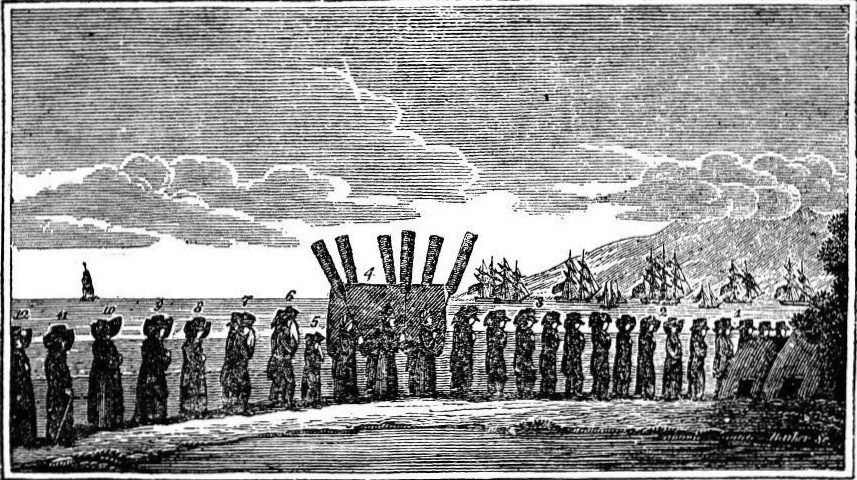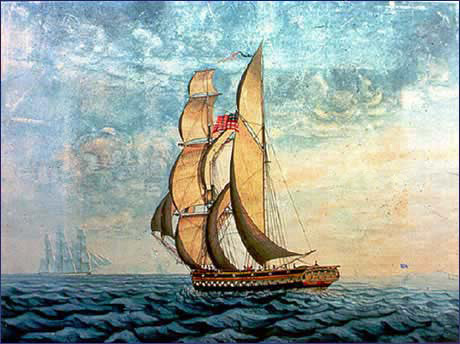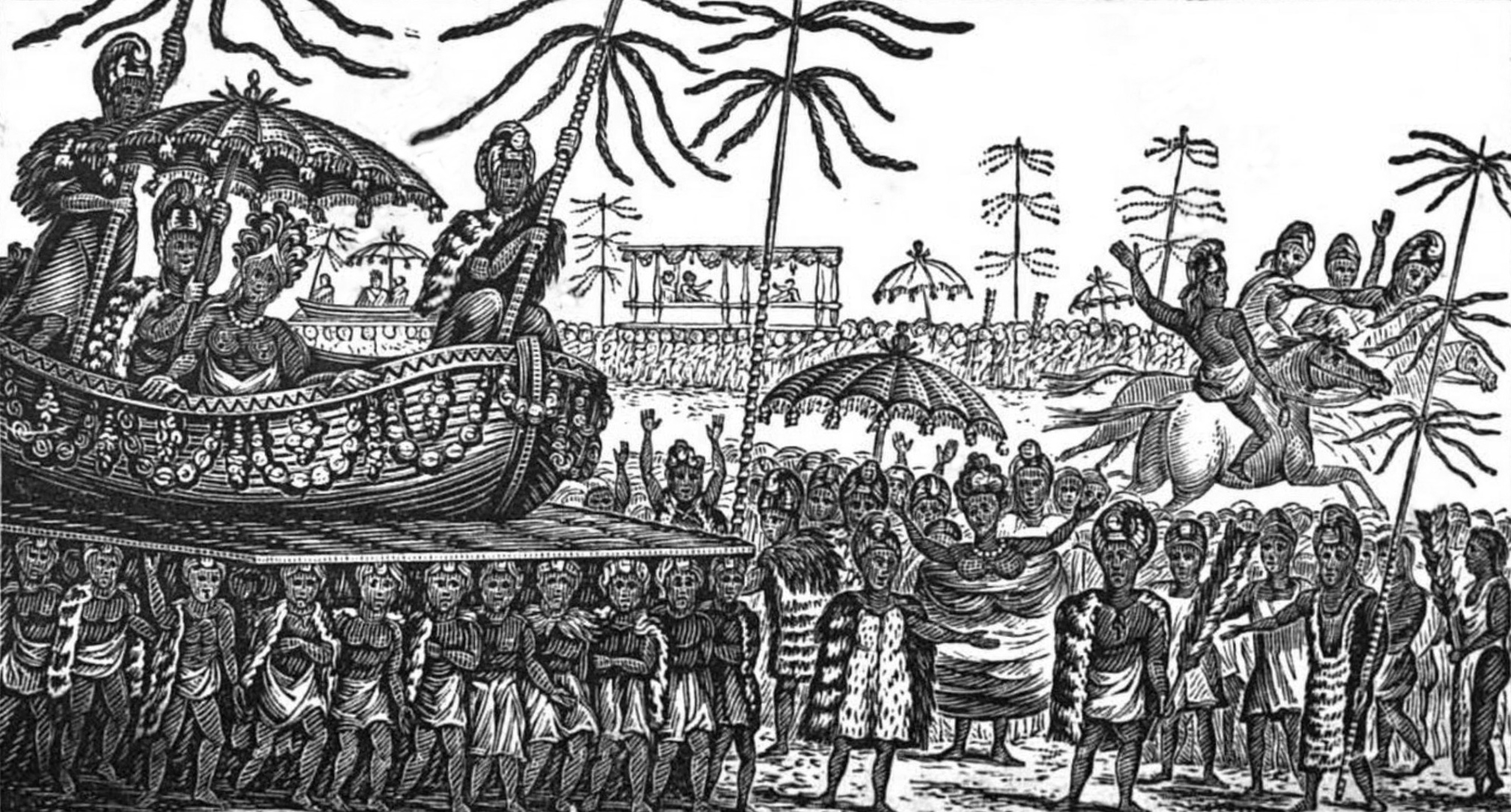|
Kekauʻōnohi
Keahikuni Kekauʻōnohi (c. 1805–1851) was a Hawaiian high chiefess who was a member of the House of Kamehameha. She was granddaughter to King Kamehameha I and one of the wives of Kamehameha II. Her Christian name is disputed; it is given as Mikahela in the 1848 Mahele Book and as Miriam in later sources. Biography She was born circa 1805 at Lahaina, Maui. Her father was Kahōʻanokū Kīnaʻu. Her mother was Kahakuhaʻakoi Wahinepio, sister of Boki and Kalanimoku and granddaughter of Alii Nui, Kekaulike of Maui. Her father was a son of Kamehameha I and his wife Peleuli, daughter of Kamanawa, one of the royal twins. She married her uncle Kamehameha II. She was one of his five wives. Others were Kamāmalu, Pauahi, Kīnaʻu, and Kekāuluohi. She was the youngest, but Kamāmalu was Liholiho's favorite. She was at the famous meal when the ''kapu'' system was overturned in 1819, known as the ʻAi Noa. After Liholiho's death in London, she went to Kauaʻi to live wit ... [...More Info...] [...Related Items...] OR: [Wikipedia] [Google] [Baidu] |
Wahinepio
Kahakuhaʻakoi Wahinepio (died 1826) was a Hawaiian chiefess and member of the royal family during the Kingdom of Hawaiʻi. Wahinepio means ''captive women'' in Hawaiian. Sometimes she is called Wahineopiʻo, or an extra ʻokina is added, calling her Kahakuhaʻakoʻi. She was also called Kamoʻonohu. She was considered Kamehameha I's third favorite wife and served as female Governor of Maui, an act unheard of at the time in the western world, but common in Hawaiian history. Life She was born on the island kingdom of Maui. Her father was Kekuamanoha, and her mother was Kamakahukilani, the niece of her father. Through her father she was a granddaughter of Kekaulike, the King or Moʻi of Maui. Her mother was the daughter of Kauhiaimokuakama, the eldest son of Kekaulike, who was denied the right of succession to the throne of Maui due to his mother Kahawalu's inferior rank in contrast to Kekaulike's other wife Kekuiapoiwa I. Supported by King Peleioholani of Oahu, he fough ... [...More Info...] [...Related Items...] OR: [Wikipedia] [Google] [Baidu] |
Kamehameha II
Kamehameha II (November 1797 – July 14, 1824) was the second king of the Kingdom of Hawaii. His birth name was Liholiho and full name was Kalaninui kua Liholiho i ke kapu ʻIolani. It was lengthened to Kalani Kaleiʻaimoku o Kaiwikapu o Laʻamea i Kauikawekiu Ahilapalapa Kealiʻi Kauinamoku o Kahekili Kalaninui i Mamao ʻIolani i Ka Liholiho when he took the throne. Early life Kamehameha II was born in the month of Hanaiaʻeleʻele (corresponding to November) 1797 in Hilo, on the island of Hawaiʻi, the first born son of Kamehameha I with his highest-ranking wife Keōpuolani. It was originally planned that he would be born at the Kūkaniloko birth site on the island of Oʻahu but the Queen's sickness prevented travel. Given in care to his father's trusted servant Hanapi, who took the child to rear him in the lands of Kalaoa in Hilo Paliku, he was taken back, after five or six months, by his maternal grandmother Kekuʻiapoiwa Liliha because she felt he was not getting ... [...More Info...] [...Related Items...] OR: [Wikipedia] [Google] [Baidu] |
Waiola Church
Waiola Church is the site of a historic mission established in 1823 on the island of Maui in Hawaii. Originally called Wainee Church until 1953, the cemetery is the final resting place for early members of the royal family of the Kingdom of Hawaii. History The first mission to Maui was founded by Reverend William Richards (1793–1847) in 1823. For a few years, temporary structures made from wooden poles with a thatched roof were used. In 1828, island Governor Hoapili supported the building of a stone and wood structure. The Christian church was built adjacent to a pond surrounding an island called Mokuula, which was sacred to traditional Hawaiian religion and residence of the king. The first stone building was dedicated on March 4, 1832 and called Wainee Church. Rev. Ephraim Spaulding (1802–1840) joined with his wife Juliet Brooks (1810–1898) from 1832 to 1836. Rev. Dwight Baldwin transferred here in 1836, and served as physician, even though trained in theology. The Bald ... [...More Info...] [...Related Items...] OR: [Wikipedia] [Google] [Baidu] |
Abigail Maheha
Abigail Maheha (July 10, 1832 – February 13, 1861) was a Hawaiian chiefess (aliʻi) of the Kingdom of Hawaii. At a young age, she was chosen to attend the Chiefs' Children's School (later renamed the Royal School) taught by the American missionary Amos Starr Cooke and his wife, Juliette Montague Cooke, alongside her half-sister Jane Loeau and fourteen of her royal cousins. Early life and education Maheha was the daughter of High Chief Namaile and High Chiefess Kuini Liliha. Her mother was the royal governor of Oʻahu during the regency of Queen Kaʻahumanu. She was descended from Kahekili II, Moi of Maui, and High Chief Hoapili. ; ; She was adopted or ''hānaied'' by her aunt, Princess Kekauʻōnohi. Her ''hānai'' mother was a granddaughter of Kamehameha the Great who united the Hawaiian Islands into one kingdom and was also the youngest consort of the deceased Kamehameha II and served as Governor of Kauaʻi. She was among those chosen by King Kamehameha III eligible fo ... [...More Info...] [...Related Items...] OR: [Wikipedia] [Google] [Baidu] |
Kiliwehi
Mary Ann Kiliwehi Kaʻauwai ( – November 4, 1873) was a Hawaiian high chiefess and lady-in-waiting of the Kingdom of Hawaii. Alongside her husband William Hoapili Kaʻauwai, she traveled with Queen Emma of Hawaii to Europe between 1865 and 1866, and circumnavigated the globe upon their return eastward via New Zealand. Early life Kiliwehi was born , as the daughter of Kuini Liliha, an influential high chiefess and Governor of Oahu, and Haʻalou (different from the chief executed for adultery with one of Kamehameha II's wives in 1822). Her mother was a descendant of the ancient kings of Hawaii and Maui. Kiliwehi was also the name of an early Hawaiian high chiefess who was the daughter of King Kamehameha I and Peleuli, the wife of Prime Minister Kalanimoku and the mother of Leleiohoku I. She had many half-siblings including sisters: Jane Loeau (1828–1873), Abigail Maheha (1832–1861), and Kailinoa, and brothers: Pius F. Koakanu (died 1880) and Aberahama Kaikioewa P ... [...More Info...] [...Related Items...] OR: [Wikipedia] [Google] [Baidu] |
Peleuli
Peleuli ( fl. 19th century), formally Peleuli-i-Kekela-o-kalani, was a Queen consort of the Kingdom of Hawaii as a wife of king Kamehameha I. Biography She was a daughter of High Chief Kamanawa and High Chiefess Kekelaokalani. Her father, along with his brother Kameʻeiamoku, were known as one of the "royal twins" who helped Kamehameha I come to power and served as advisors. Her mother was the daughter of High Chief Kauakahiakua, son of Lonomakahonua and Kahapoohiwi, and High Chiefess Kekuʻiapoiwa I, once the wife of King Kekaulike of Maui. She had three brothers: Koahou, Noukana and Amamalua, and a half-sister Piʻipiʻi Kalanikaulihiwakama. In 1920, Elizabeth Kekaaniau published a book accounting the history of the descendants of Keōua. In the book, Elizabeth Kekaaniau stated that Piʻipiʻi Kalanikaulihiwakama and Peleuli were the daughters of Keōua and Kekuʻiapoiwa II, therefore full-blood sisters of Kamehameha I. Many sources also incorrectly call her an aunt of Kameh ... [...More Info...] [...Related Items...] OR: [Wikipedia] [Google] [Baidu] |
Kamanawa
''For other persons with this name, please see Kamanawa II.'' Kamanawa (died c. 1802?) was a Hawaiian high chief and early supporter of King Kamehameha I, known as one of the royal ''Nīʻaupiʻo'' twins with his brother Kameeiamoku. He later became the stepfather of Kamehameha by marrying his mother. Life Kamanawa's father was Keawepoepoe. His mother was Kanoena, sister of his father. His namesake grandnephew Kamanawa II (grandson of his twin) was grandfather of the last two ruling monarchs of the Kingdom. The name ''ka manawa'' (sometimes spelled "Ka-manawa") means "the season" in the Hawaiian language. His first wife was named the High Chiefess Kekelaokalani of Maui, the daughter of his aunt, Queen Kekuiapoiwanui of Maui, by her second marriage to High Chief Kauakahiakua-o-Lono of Maui. His second wife was Chiefess Kekuiapoiwa II, the mother of Kamehameha I. He had three sons: Koahou, Noukana, and Amamalua from his first wife. He also has a daughter Peleuli, who became a co ... [...More Info...] [...Related Items...] OR: [Wikipedia] [Google] [Baidu] |
Kamāmalu
Kamāmalu Kalani-Kuaʻana-o-Kamehamalu-Kekūāiwa-o-kalani-Kealiʻi-Hoʻopili-a-Walu (–1824) was Queen consort of the Kingdom of Hawaiʻi as the wife of King Kamehameha II. Kamāmalu was short for Kamehamalu or Kamehamehamalu meaning "the Shade of the Lonely One", honoring her father, "the Lonely One". She is not to be confused with her niece, Princess Victoria Kamāmalu. Life She was the eldest daughter of Queen Kalākua Kaheiheimālie and King Kamehameha I. She was referred to as Kekūāiwa for the early part of her life. According to John Papa ʻĪʻī, she was betrothed to her half-brother Kamehameha II from birth and they were married when she was twelve and he was seventeen or eighteen. Her younger sister Kīnaʻu later also became wife of Kamehameha II as did their half-sister Kekauluohi by their mothers Kalakua Kaheiheimalie. Even though her husband had four other wives (two of them her sisters and the two others her nieces), Kamāmalu was her husband's favorite wife ... [...More Info...] [...Related Items...] OR: [Wikipedia] [Google] [Baidu] |
Kīnaʻu
Princess Kalani Ahumanu i Kaliko o Iwi Kauhipua o Kīnau, also known as Elizabeth Kīnau ( – April 4, 1839) was Kuhina Nui of the Kingdom of Hawaii as Kaahumanu II, Queen regent and Dowager Queen. Life Her father was King Kamehameha I and her mother was Kalākua Kaheiheimālie. She was born probably in 1805 on the island of Oahu at Waikiki. She was given in ''hānai'' to her stepmother Peleuli and her second husband Kawelookalani, her father's half-brother. Peleuli named her Kīnau after her son Kahōanokū Kīnau (her half-brother) and took her back to the island of Hawaii after Kamehameha moved his capital back to Kailua-Kona. Kīnau was first married to her half-brother Liholiho (1797–1824) who ascended in 1819 as King Kamehameha II. In 1824, at around 19 years of age, she became Dowager Queen when Kamehameha II died in London with his favorite wife (her sister) Queen Kamāmalu. Her second husband was Kahalaia Luanuu, a grandson of Kamehameha I. She had a son who peri ... [...More Info...] [...Related Items...] OR: [Wikipedia] [Google] [Baidu] |
Kalanipauahi
Pauahi (c.1804–1826) was a member of the royal family of the Kingdom of Hawaii in the House of Kamehameha. Referred as Pauahi in her lifetime, she is often referred to as Kalanipauahi or Kalani Pauahi to differentiate her from her niece and namesake Bernice Pauahi Bishop. Life Pauahi was born circa 1804. Her mother was Keouawahine, daughter of Kauhiwawaeono of Maui by his wife, chiefess Loe-wahine, who in turn was daughter of Kameeiamoku. Her father was the High Chief Pauli Kaʻōleiokū (1767–1818). The name ''Pauahi'' originated in an incident which occurred in her childhood. By an accidental explosion of gunpowder she narrowly escaped being burned to death. Five men were killed in the catastrophe, her mother house was burned to the ground, and she was badly injured. In commemorating her escape she was given the name Pauahi, which is composed of two Hawaiian words, ''pau'', "finished", or "completed" and ''ahi'', "fire", which, when translated, means "the fire is out". ... [...More Info...] [...Related Items...] OR: [Wikipedia] [Google] [Baidu] |
Boki (Hawaiian Chief)
Boki (sometimes Poki, born Kamāuleule) (before 1785–after December 1829) was a High Chief in the ancient Hawaiian tradition and served the Kingdom of Hawaii as royal governor of the island of Oahu. Boki ran a mercantile and shipping business and encouraged the Hawaiians to gather sandalwood for trade. Early life Boki was the son of Kekuamanoha and Kamakahukilani. His father was a chief of Maui and grandson of Kekaulike, King of Maui. He was a younger brother of William Pitt Kalanimoku, but it was rumored that he was a son of Kahekili II. His original name was Kamāuleule ("The one who faints") and his nickname came from a variation of "Boss", the name of Kamehameha I's favorite dog which was a very common name for dogs in Hawaii at the time. Royal governor Boki was appointed Royal Governor of Oahu and chief of the Waianae District by Kamehameha I, and continued in his post under Kamehameha I's son Kamehameha II. Boki and his wife Kuini Liliha (1802—1839) were leadi ... [...More Info...] [...Related Items...] OR: [Wikipedia] [Google] [Baidu] |






